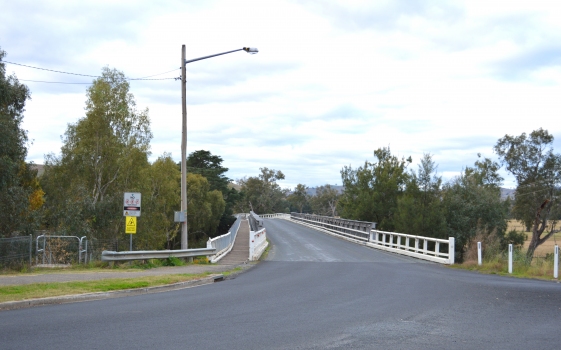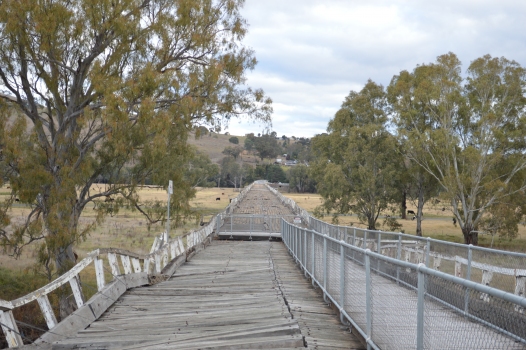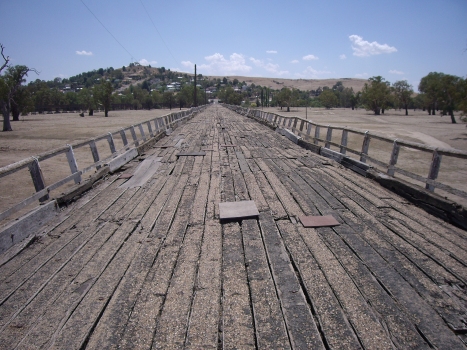General Information
| Completion: | 17 October 1867 |
|---|---|
| Status: | partially in service |
Project Type
| Function / usage: |
Road bridge |
|---|---|
| Structure: |
Deck truss bridge |
| Material: |
main bridge: Iron bridge Structurae Plus/Pro - Subscribe Now! approach viaducts: Timber bridge |
Location
| Location: |
Gundagai, Gundagai Shire Council, New South Wales, Australia |
|---|---|
| Address: | Middleton Drive |
| Crosses: |
|
| Coordinates: | 35° 4' 28.11" S 148° 6' 24.78" E |
Technical Information
Dimensions
| total length | 313.9 m | |
| main spans (3x) | 31.4 m |
Materials
| piers |
wood
|
|---|---|
| deck of approach viaducts |
wood
|
| main trusses |
wrought iron
|
Excerpt from Wikipedia
The Prince Alfred Bridge is a wrought iron truss and timber beam road bridge over the Murrumbidgee River and its floodplain at Gundagai, New South Wales.
The bridge was named for the then reigning Queen Victoria's son, Prince Alfred, Duke of Saxe-Coburg and Gotha, and was built to carry the Great Southern Road (now the Hume Highway) across the Murrumbidgee. It has existed in three forms, with only the main spans across the river itself being common to all three.
As opened in 1867 the bridge had a total length of 1,030 feet (313.9 m), consisting of three wrought iron truss spans each of 103 feet (31.4 m) across the river, two timber southern approach spans each of 30 feet (9.1 m), and twenty-three timber northern approach spans each of 30 feet (9.1 m), rising on a gradient of 1 in 30 from the level of the floodplain.
It was the first iron truss bridge to be built in New South Wales, The pin-jointed Warren truss section is the second-oldest metal truss bridge in Australia. It was designed by William Bennett, Engineer and Commissioner for Roads and constructed by Francis Bell.
The trusses were assembled from iron work imported from England. The cylinders for the main piers were cast at the Fitzroy Iron Works at Mittagong, using iron smelted from locally-mined ore in their blast furnace. There were 56 cylindrical castings weighing between 2.25 and 2.5 tons each - with one cylinder being nine feet long, six feet in diameter, with a wall-thickness of 1.125 inches. The cylinders were sunk through alluvial deposits to a foundation in coarse gravel and detached pieces of rock, the deepest being founded about 30 feet below low water level.
After the opening, work continued with construction of the rest of the high-level bridge with work expected to finish within eight months. The second configuration of the bridge was built by the twenty-three northern approach spans being replaced by a much longer structure which spanned the full width of the floodplain. It consisted of 105 timber spans varying from 15 feet (4.6 m) to 30 feet (9.1 m) long, but as far back as 1932 the details of this configuration of the bridge had been lost, and no further details are known, other than the fact that it was 12.2 m longer than the bridge which replaced it.
In 1896 the third configuration of the bridge was completed. The northern spans and southern approach spans were all replaced. The northern spans were replaced by seventy-five spans of 35 feet (10.7 m) and one of 28 feet (8.5 m), one of the longest timber beam bridges in Australia. The alignment of this new approach was slightly to the west of the previous (second) northern approach. The two southern spans of 30 feet (9.1 m) dating from 1865 were replaced by one span of 35 feet (10.7 m) and one of 28 feet (8.5 m) on the same alignment as the previous southern approach spans.
In addition a side ramp was built on the western side in 1896, leading down from the bridge six spans north of the main spans down to ground level of the floodplain beneath the approach spans, as it had already become necessary to reduce wear and tear on the timber approach spans. After the 1896 reconstruction the bridge had a total length of 3,025 feet (922.0 m), and remained the longest bridge in New South Wales until the opening of the Sydney Harbour Bridge in 1932.
In 1977, the 1,143 metres (3,750 ft) long Sheahan Bridge, replaced the Prince Alfred Bridge as the Hume Highway crossing of the Murrumbidgee River. This bridge was duplicated in 2010.
Since the opening of the Sheahan Bridge the Prince Alfred Bridge has served local traffic only, but since being superseded by the Sheahan Bridge the timber spans have deteriorated to such an extent that the 1896 side ramp has had to be reinstated, so that most of the northern approach is disused, and has deteriorated to the point where it is closed not only to vehicular traffic but also to pedestrians.
Text imported from Wikipedia article "Prince Alfred Bridge" and modified on July 23, 2019 according to the CC-BY-SA 4.0 International license.
Participants
Relevant Web Sites
- About this
data sheet - Structure-ID
20077605 - Published on:
25/06/2019 - Last updated on:
25/06/2019







